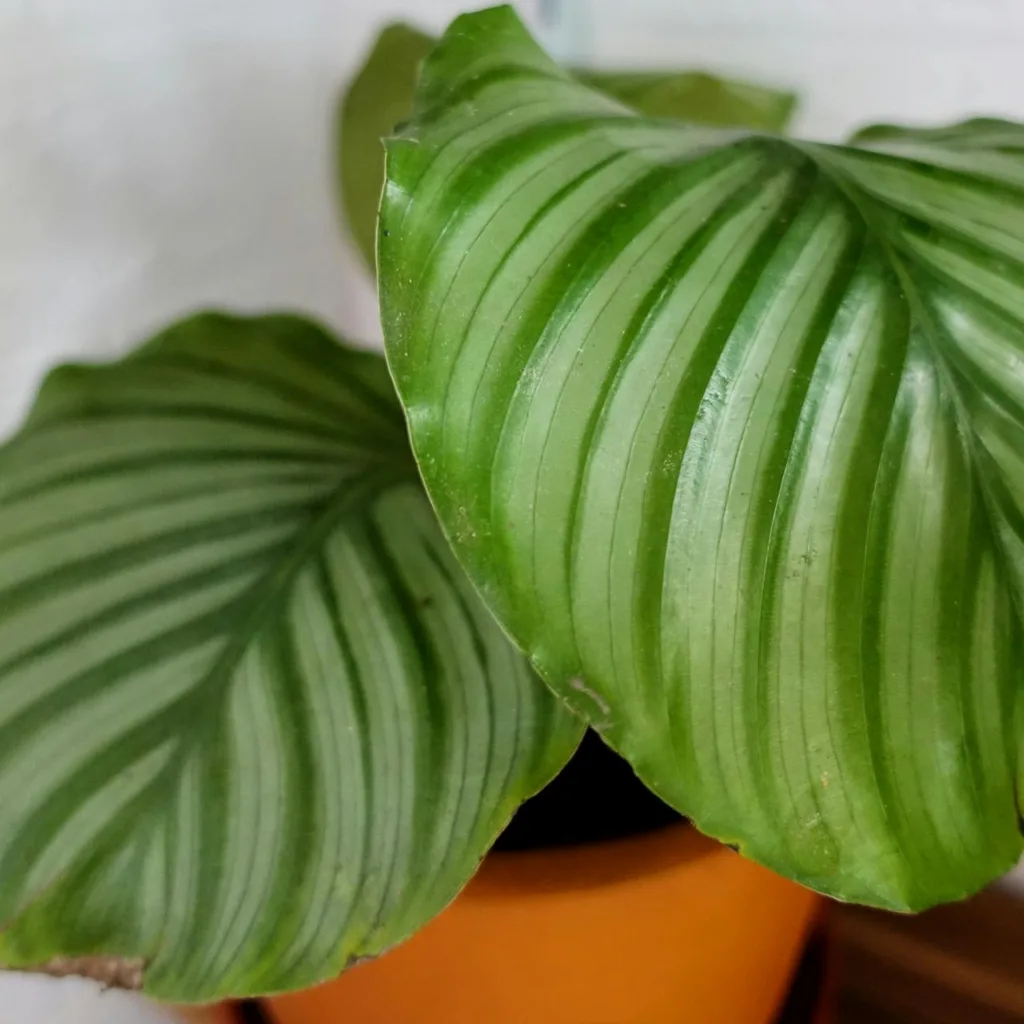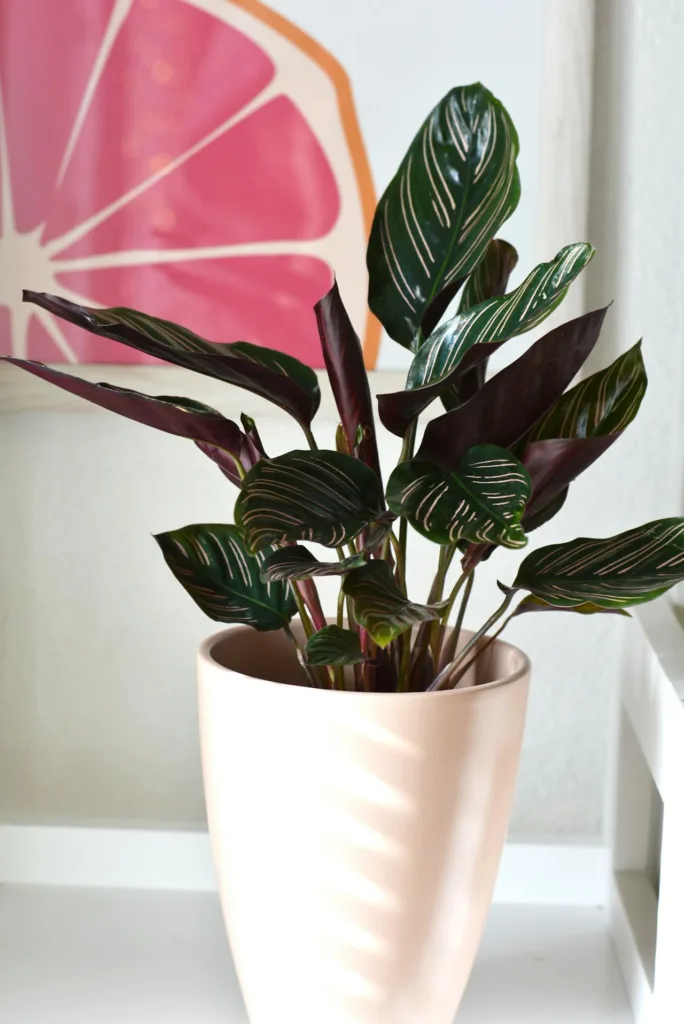Calathea Warscewiczii, also known as “jungle velvet calathea,” is a tropical plant from the Marantaceae family. This perennial plant is native to the rainforests of Nicaragua and Costa Rica in Central America.
Its vibrant leaves and air-purifying qualities make it a popular choice for indoor gardens and homes with a tropical vibe. If you’re interested in cultivating and caring for a Calathea Warscewiczii, this guide will provide all the information you need for its healthy growth and vibrant appearance.
| Aspect | Description |
|---|---|
| Scientific Name | Calathea warscewiczii |
| Common Name | Jungle Velvet Calathea |
| Family | Marantaceae |
| Genus | Calathea |
| Native Region | Rainforests of Nicaragua and Costa Rica, Central America |
| Plant Type | Evergreen Perennial |
| Foliage | Large, velvety leaves with dark green upper surface, light green stripes, and burgundy underside |
| Leaf Arrangement | Broad, ovate leaves arranged in a rosette-like fashion |
| Growth Habit | Clumping growth habit with new leaves emerging from the center |
| Light Requirements | Bright, indirect light; avoids direct sunlight to prevent leaf burn |
| Humidity Needs | Prefers high humidity; benefits from misting or humidity trays |
| Watering | Keep soil consistently moist, allowing the top inch to dry out before watering |
| Temperature Range | Prefers warm temperatures between 65°F to 75°F (18°C to 24°C) |
| Soil Type | Well-draining, peat-based potting mix |
| Fertilization | Feed with a balanced, diluted fertilizer during the growing season |
| Toxicity | Considered non-toxic to humans, cats, and dogs. Mild irritation possible with contact or ingestion |
| Use | Popular indoor plant for homes and offices, valued for vibrant foliage and air-purifying qualities |

What is Calathea warscewiczii
Calathea warscewiczii is a species of Calathea known for its velvety, dark-green leaves with pinkish hues on the underside.
The intricate patterns and colors on its leaves make it a popular choice for plant lovers looking to add a touch of elegance to their homes.
This plant belongs to the Marantaceae family and is closely related to other popular Calathea varieties such as the Calathea Zebrina and the Calathea Orbifolia.
Light Requirements
Calathea Warscewiczii thrives in bright, indirect light. Place your plant in a location where it can receive filtered sunlight or artificial light that mimics natural conditions.
Direct sunlight can scorch the leaves of Calathea Warscewiczii, so it’s essential to protect it from harsh rays.
A north or east-facing window is an ideal spot for this plant, as it can enjoy gentle morning sunlight without being exposed to the intense heat of the afternoon sun.
Watering Needs
Proper watering is crucial for the health of Calathea Warscewiczii. This plant prefers consistently moist soil, but it’s essential to avoid overwatering, as this can lead to root rot.
Allow the top inch of soil to dry out slightly between waterings, and ensure that your plant is potted in a well-draining container.
Water your Calathea Warscewiczii with room temperature water and ensure that excess water can drain freely from the pot to prevent waterlogging.
Temperature and Humidity Requirements
Calathea Warscewiczii thrives in warm, humid conditions similar to its native habitat in Brazil. Maintain a temperature range between 65°F to 80°F (18°C to 27°C) for optimal growth.
Ensure that your plant is positioned away from drafts or heating vents, as sudden temperature fluctuations can stress the plant.
To increase humidity levels, consider using a humidifier near your Calathea Warscewiczii or placing a pebble tray filled with water beneath the plant.
Soil and Fertilization
Calathea Warscewiczii thrives in a well-draining, peat-based potting mix that retains moisture without becoming waterlogged.
A mixture of peat moss, perlite, and bark is ideal for this plant’s growth. Fertilize your Calathea Warscewiczii every 4-6 weeks during the growing season with a balanced, water-soluble fertilizer diluted to half-strength. Avoid over-fertilizing, as this can lead to salt buildup in the soil and cause nutrient imbalances.

Pruning and Propagation
Regular pruning is essential to maintain the shape and appearance of your Calathea Warscewiczii. Trim any yellowing or damaged leaves using clean, sharp scissors to stimulate new growth.
Calathea Warscewiczii can be propagated by division, which involves separating the plant into smaller sections with roots attached.
Make sure each division has healthy roots and transfer it into a new pot with a fresh potting mix to support successful growth.
Common Pests and Problems
Calathea Warscewiczii is susceptible to common houseplant pests such as spider mites, aphids, and mealybugs.
Inspect your plant regularly for signs of pest infestations, such as webbing, sticky residue, or tiny insects on the leaves.
Treat any infestations promptly with insecticidal soap or neem oil to prevent further damage. Additionally, yellowing leaves on Calathea warscewiczii can indicate overwatering, underwatering, or nutrient deficiencies, so addressing these issues promptly is essential.
Repotting
Repotting your Calathea Warscewiczii every 1-2 years is necessary to prevent root-bound and promote healthy growth.
Choose a pot that is one size larger than the current container and refresh the potting mix to provide fresh nutrients for the plant.
Gently loosen the roots and place your Calathea Warscewiczii in the center of the new pot, ensuring that the soil level remains the same as before. Water the plant thoroughly after repotting to help it settle into its new home.
Enjoying the Beauty of Calathea warscewiczii
Following these care guidelines ensures that your Calathea Warscewiczii remains healthy, vibrant, and beautiful.
This stunning plant is a great addition to any indoor space, adding a touch of lush greenery and elegance to your home.
Take the time to observe and care for your Calathea Warscewiczii, and you’ll be rewarded with lush, velvety leaves and a thriving plant that will brighten your surroundings for years to come.
Remember, each plant has unique needs and preferences, so paying attention to your Calathea Warscewiczii and adjusting your care routine as needed is essential.
With patience, dedication, and a little bit of love, you can create the perfect environment for your Calathea Warscewiczii to grow and thrive. So go ahead, bring home this beautiful plant, and enjoy the serenity and beauty it brings to your living space!
Calathea warscewiczii vs zebrina
| Feature | Calathea warscewiczii | Calathea zebrina |
|---|---|---|
| Common Name | Jungle Velvet Calathea | Zebra Plant |
| Leaf Appearance | Dark green, velvety leaves with a light green fishtail pattern | Bright green, velvety leaves with darker green zebra-like stripes |
| Leaf Underside Color | Purple | Purple |
| Growth Habit | Upright, clumping | Upright, clumping |
| Height | Up to 2 feet (60 cm) | Up to 3 feet (90 cm) |
| Light Requirements | Bright, indirect light | Bright, indirect light |
| Watering Needs | Keep soil consistently moist, but not waterlogged | Keep soil consistently moist, but not waterlogged |
| Humidity Requirements | High humidity (above 60%) | High humidity (above 60%) |
| Temperature Range | 65-80°F (18-27°C) | 65-80°F (18-27°C) |
| Soil Type | Well-draining, peat-based soil | Well-draining, peat-based soil |
| Fertilization | Monthly during the growing season with diluted houseplant fertilizer | Monthly during growing season with diluted houseplant fertilizer |
| Propagation | Division | Division |
| Common Problems | Leaf curling, browning edges, spider mites | Leaf curling, browning edges, spider mites |
| Toxicity | Non-toxic to pets | Non-toxic to pets |
Similarities:
- Both require bright, indirect light and high humidity.
- Both need consistently moist soil and thrive in similar temperature ranges.
- Both are non-toxic to pets and have similar care and maintenance needs.
FAQs
Is Calathea warscewiczii an indoor plant?
- Yes, Calathea warscewiczii is commonly grown as an indoor plant. Its vibrant foliage and adaptability to indoor conditions make it a popular choice for homes and offices.
Can Calathea warscewiczii live in water?
- No, Calathea warscewiczii cannot thrive in water alone. It is a terrestrial plant that requires well-draining soil for its roots. Overly wet conditions, such as constantly soggy soil, can lead to root rot.
Is Calathea Warscewiczii toxic?
- Calathea warscewiczii is considered non-toxic to humans, cats, and dogs. However, it’s always advisable to keep plants out of reach of pets and small children. While not harmful if ingested, some individuals may experience mild irritation if they come into contact with the sap or juices of the plant.
